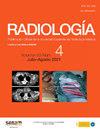伴有或不伴有动脉静脉瘘的肾动脉伪萎靡性动脉瘤经动脉栓塞对肾功能的影响随访6个月
IF 1.1
Q3 RADIOLOGY, NUCLEAR MEDICINE & MEDICAL IMAGING
引用次数: 0
摘要
经动脉栓塞(TAE)是医源性肾动脉假性动脉瘤(PSA)和假性动脉瘤合并动静脉瘘(PSA + AVF)的金标准治疗方法,但其对肾功能的影响尚未得到充分研究。本研究的目的是评估TAE对肾功能的影响及其技术和临床效果。材料和方法回顾性分析2006年12月至2020年10月两个中心61例连续患者的67例栓塞手术,其参数如下:技术和临床的成功和失败,栓塞材料,血管损伤的类型和尺寸,术后缺血性肾实质的百分比和估计肾小球滤过率(eGFR)值术前和术后1天,经皮或内镜(SPE)手术,TAE术前,术后1天和术后6个月。结果PSA 44例,PSA + AVF 23例。技术成功率为95.5%,主要临床成功率为90.2%,次要临床成功率为96.7%。采用不同的栓塞材料。在SPE手术后发现eGFR显著下降。经TAE前后eGFR无明显差异。经TAE 6个月后发现eGFR有微小的显著改善。栓塞更大的病变导致更大的术后缺血区域。PSA + AVF差异有统计学意义(P = 0.0142),表明术后缺血面积较大。血管损伤的大小、种类及术后缺血面积与eGFR无相关性。结论tae具有较高的技术和临床成功率,无论血管损伤的大小、种类或术后缺血区域如何,对肾功能均无不良影响。本文章由计算机程序翻译,如有差异,请以英文原文为准。
Efecto de la embolización transarterial de pseudoaneurismas yatrógenos de la arteria renal con o sin fístula arteriovenosa sobre la función renal a los 6 meses de seguimiento
Introduction
Transarterial embolization (TAE) is the gold standard treatment for iatrogenic renal artery pseudoaneurysms (PSA) and pseudoaneurysms with arteriovenous fistula (PSA + AVF), but its impact on renal function has not been sufficiently investigated. The aim of the study is to assess the impact on of TAE on renal function and its technical and clinical effectiveness.
Materials and methods
Sixty-seven embolization procedures in 61 consecutive patients from December 2006 to October 2020 in two centers were retrospectively reviewed for the following parameters: technical and clinical success and failure, embolization materials, type and dimensions of vascular injuries, percentage of post-procedural ischemic renal parenchyma and estimated glomerular filtration rate (eGFR) values before and 1 day after the surgical, percutaneous or endoscopic (SPE) procedure and before, 1 day after and 6 months after TAE.
Results
We identified 44 PSA and 23 PSA + AVF. Technical success was 95.5%, primary clinical success was 90.2% and secondary clinical success was 96.7%. Different embolization materials were used. A significant decrease of the eGFR was found after the SPE procedure. No significant difference was found between eGFR before and after TAE. A minimal significant improvement of the eGFR was found 6 months after TAE. Embolization of larger lesions resulted in larger post-procedural ischemic areas. PSA + AVF were significantly larger (P = .0142) and determined a larger post-procedural ischemic area. No correlation was found between dimensions, kind of vascular injury or post-procedural ischemic area and eGFR.
Conclusion
TAE has high technical and clinical success rates and does not affect renal function negatively, regardless of dimensions or kind of vascular injuries or post-procedural ischemic area.
求助全文
通过发布文献求助,成功后即可免费获取论文全文。
去求助
来源期刊

RADIOLOGIA
RADIOLOGY, NUCLEAR MEDICINE & MEDICAL IMAGING-
CiteScore
1.60
自引率
7.70%
发文量
105
审稿时长
52 days
期刊介绍:
La mejor revista para conocer de primera mano los originales más relevantes en la especialidad y las revisiones, casos y notas clínicas de mayor interés profesional. Además es la Publicación Oficial de la Sociedad Española de Radiología Médica.
 求助内容:
求助内容: 应助结果提醒方式:
应助结果提醒方式:


